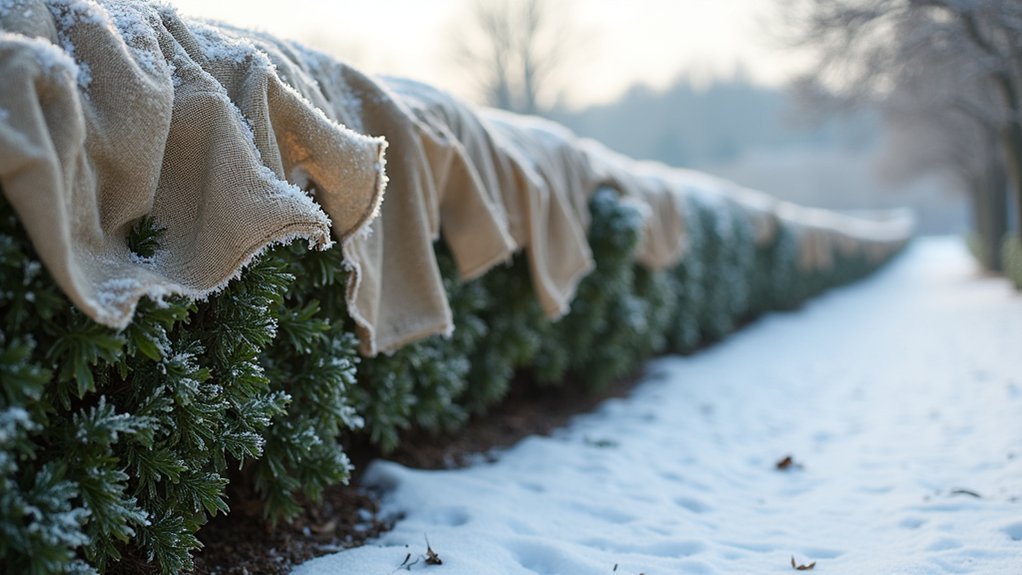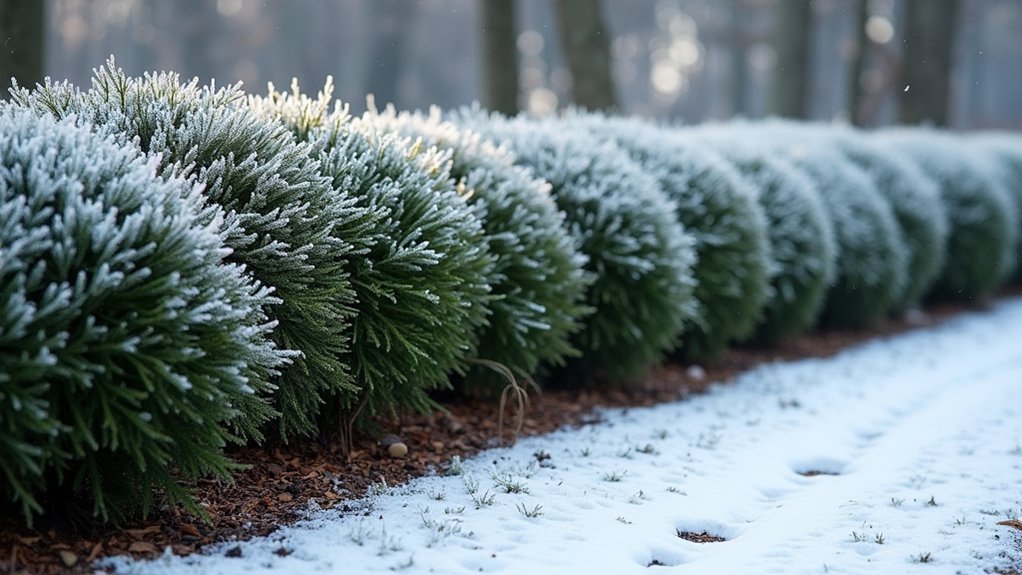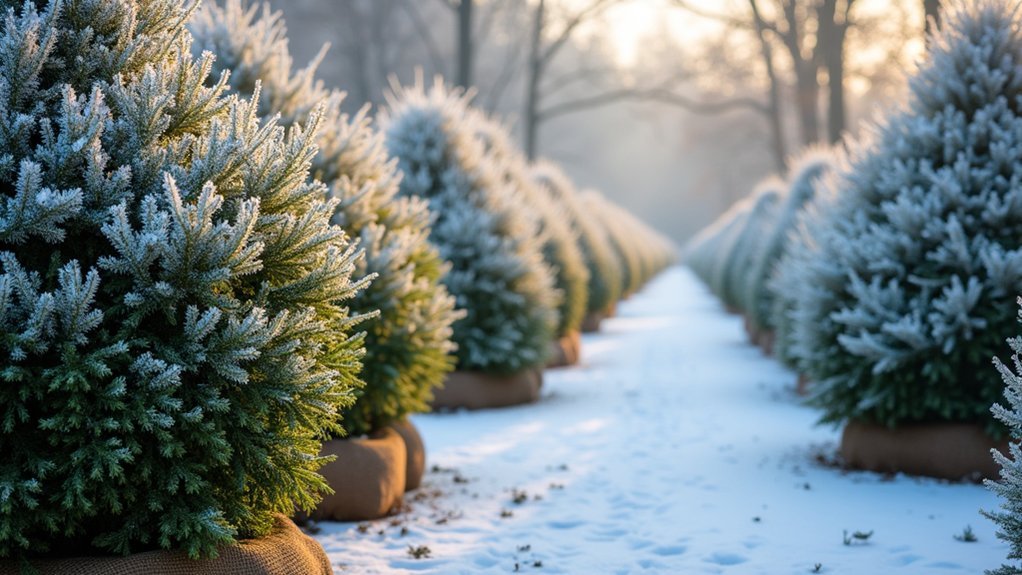To winterize hedge barriers, use 2-2.5 oz polypropylene fabric or thermal fleece blankets for established hedges and 1 oz breathable covers for newer plantings. Apply anti-desiccant sprays to evergreens before wrapping. Secure with stakes, allowing air circulation, and add 3-4 inches of mulch around roots. Install wire mesh barriers to prevent rodent damage. Position wind barriers perpendicular to prevailing winds. These essentials will transform your vulnerable hedges into resilient winter survivors.
Selecting the Right Frost Protection Materials for Hedges

When protecting your hedge barriers from winter’s harsh conditions, selecting the right frost protection materials becomes essential for plant survival.
Look for high-quality polypropylene fabrics or thermal fleece blankets that can raise temperatures underneath by 4-6°F while remaining breathable.
For established hedges, choose heavier materials (2-2.5 oz) that offer superior wind and snow resistance.
Newer plantings benefit from lighter (1 oz) breathable covers that prevent moisture buildup while still providing frost protection.
UV-resistant options deliver dual protection against winter sun damage and freezing temperatures.
Consider your hedge configuration when selecting sizes—custom options are available for unique layouts.
While prices vary by material and dimensions, investing in durable, reusable protection now will prevent costly plant replacement in spring.
Tightly secure your frost covers around your hedges for maximum effectiveness, as tightly wrapped covers significantly improve the protective barrier against cold air infiltration.
Proper Installation Techniques for Winter Barriers
Three key steps must be completed before installing winter barriers around your hedge: thoroughly assess hedge condition, clean the surrounding area, and perform strategic pruning.
When installing barriers, secure burlap wraps with sturdy stakes that can withstand winter winds. The material should be loose enough to allow air circulation but tight enough to stay in place during storms. Apply anti-desiccant sprays to evergreens before wrapping to provide an additional moisture-preserving barrier.
For vulnerable hedge bases, install hardware cloth by burying it several inches below soil level to prevent rodent entry.
For evergreens, guarantee barriers don’t compress branches. Instead, create a protective frame around the hedge. Place stakes at regular intervals and attach your protective material with flexible ties that won’t damage bark when branches move in the wind.
Always inspect installations after storms to maintain their effectiveness.
Strategic Wind and Snow Management Around Living Fences

Living fences require strategic management to effectively control winter’s harsh elements.
Position your barriers perpendicular to prevailing winds to maximize snow and dust containment. Aim for 50% porosity in your hedge design—this balance allows controlled wind passage while preventing structural damage.
Perpendicular barrier placement with moderate porosity creates the ideal balance between wind control and structural integrity.
Remember the critical height-to-distance ratio of 1:10-12; a 4-foot hedge protects 40-48 feet downwind. Place barriers 40-72 feet from roadways to prevent drifts on traveled surfaces.
For maximum effectiveness, layer vegetation types (trees, shrubs, grasses) to enhance snow-trapping density. Install a minimum of 2-3 rows of vegetation for adequate protection against winter winds and snow.
For maximum effectiveness, layer vegetation types (trees, shrubs, grasses) to enhance snow-trapping density.
You’ll see multiple benefits beyond snow control: reduced road maintenance costs, enhanced soil moisture retention, and wildlife habitat creation.
Consider combining permanent hedges with standing crop rows for temporary reinforcement during harsh winter months.
Temperature Regulation Methods for Hedge Root Systems
Protecting your hedge barriers against winter’s fury extends beyond wind and snow management to the essential root systems below ground.
Apply a 3-4 inch layer of organic mulch around the root zone while keeping it away from stems to prevent rot. This buffers against temperature fluctuations when soil drops below 40°F.
Monitor soil moisture biweekly and water lightly at the base when needed, avoiding overwatering which increases frost damage. Maintain soil moisture consistently and water thoroughly before the ground freezes to support root health during winter dormancy.
Cease fertilization by early autumn, though potassium-rich feeds applied before winter can enhance cell wall strength and cold tolerance.
For potted hedges, move containers indoors or insulate them thoroughly.
In clay soils, watch for heaving during freeze-thaw cycles and stabilize with additional mulch.
Well-drained soils maintain more stable temperatures than compacted areas.
Preventing Rodent Damage During Winter Dormancy

While hedge barriers rest in their dormant winter state, they face a significant threat from hungry rodents seeking food and shelter in the harsh cold.
Mice, voles, and rabbits actively burrow under snow, targeting the vulnerable base of your hedges where they’ll gnaw on bark for sustenance.
Protect your investment by installing wire mesh barriers around the base of hedge plants.
Shield your hedges with wire mesh barriers – a small effort that safeguards your valuable landscape investment.
Apply rodent-repellent compounds like Thiram to deter chewing, and eliminate nearby tall grasses that provide shelter.
Consider planting rodent-deterrent vegetation like vetch in your landscape design.
Keep areas surrounding your hedges clean and free of debris that could harbor pests.
For severe infestations, humane trapping or professional pest control services may be necessary.
Regular monitoring throughout winter guarantees early detection and prompt intervention.
Extend protective mesh to heights exceeding the expected snowpack level to prevent rabbit damage when snow accumulates.
Frequently Asked Questions
When Should Frost Protection Materials Be Removed in Spring?
Remove frost protection materials when temperatures consistently stay above 28°F, after the last hard frost has passed. You’ll want to choose a cool, overcast day and confirm warming trends over several days before proceeding.
Can Frost Protection Materials Be Reused for Multiple Seasons?
Yes, you can reuse frost protection materials for multiple seasons. With proper care and storage in sealed bags, most covers remain effective for 2-5 years, making them a cost-effective gardening investment.
How Do Frost Protection Needs Differ for Evergreen Versus Deciduous Hedges?
Your evergreen hedges need more frost protection since they retain foliage year-round, requiring covers and windbreaks. Deciduous hedges, being dormant in winter, need less protection but benefit from mulching and branch support.
Do Frost Barriers Affect Flowering or Fruiting in Hedge Species?
Yes, frost barriers can affect your hedges’ flowering and fruiting. They’ll trap cold air that damages blossoms, but can also provide wind protection. Create gaps at the base to improve air circulation for better flowering.
What Emergency Measures Can Protect Hedges During Unexpected Frost Events?
During unexpected frost, you’ll need to cover hedges with sheets or frost covers immediately. Add incandescent lights underneath for warmth, create windbreaks, and water before freezing temperatures arrive to release protective heat.
In Summary
You’ll save your hedge barriers from winter’s harshest effects by implementing these frost protection strategies. Don’t wait until temperatures plummet—prepare now with proper materials, installation techniques, and wind management systems. Remember to insulate root systems and guard against hungry rodents. Your attention to these winterizing essentials will reward you with healthier, more vibrant hedges when spring arrives.





Leave a Reply